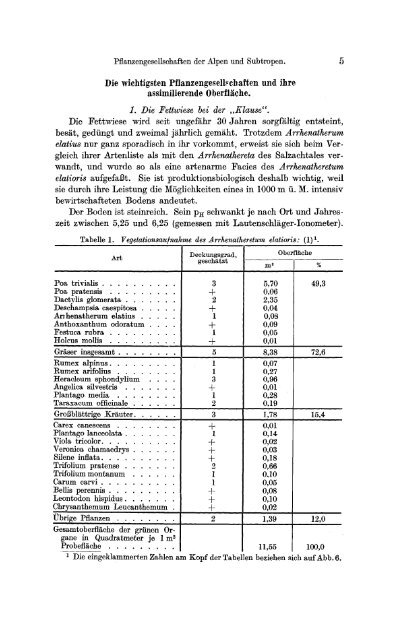Zur Frage der Oberflächenentwicklung von Pflanzengesellschaften der Alpen und Subtropen - Vareschi 1951
Vareschi, Volkmar. 1951. Zur Frage der Oberflächenentwicklung von Pflanzengesellschaften der Alpen und Subtropen. Planta 40(1): 1-35. [On the question of the surface development of plant communities of the Alps and the Subtropics] (Shared for non-commercial educational purposes only - All rights belong to authors, publishers and respective owners - http://www.jstor.org/stable/23360422?seq=1#page_scan_tab_contents)
Vareschi, Volkmar. 1951. Zur Frage der Oberflächenentwicklung von Pflanzengesellschaften der Alpen und Subtropen. Planta 40(1): 1-35. [On the question of the surface development of plant communities of the Alps and the Subtropics] (Shared for non-commercial educational purposes only - All rights belong to authors, publishers and respective owners - http://www.jstor.org/stable/23360422?seq=1#page_scan_tab_contents)
Sie wollen auch ein ePaper? Erhöhen Sie die Reichweite Ihrer Titel.
YUMPU macht aus Druck-PDFs automatisch weboptimierte ePaper, die Google liebt.
<strong>Pflanzengesellschaften</strong> <strong>der</strong> <strong>Alpen</strong> <strong>und</strong> <strong>Subtropen</strong>. 5<br />
Die wichtigsten <strong>Pflanzengesellschaften</strong> <strong>und</strong> ihre<br />
assimilierende Oberfläche.<br />
1. Die Fettwiese bei <strong>der</strong> „Klause".<br />
Die Fettwiese wird seit ungefähr 30 Jahren sorgfältig entsteint,<br />
besät, gedüngt <strong>und</strong> zweimal jährlich gemäht. Trotzdem Arrhenaiherum<br />
elatius nur ganz sporadisch in ihr vorkommt, erweist sie sich beim Ver<br />
gleich ihrer Artenliste als mit den Arrhenathereta des Salzachtales ver<br />
wandt, <strong>und</strong> wurde so als eine artenarme Facies des Arrhenatheretum<br />
elatioris aufgefaßt. Sie ist produktionsbiologisch deshalb wichtig, weil<br />
sie durch ihre Leistung die Möglichkeiten eines in 1000 m ü. M. intensiv<br />
bewirtschafteten Bodens andeutet.<br />
Der Boden ist steinreich. Sein pH schwankt je nach Ort <strong>und</strong> Jahres<br />
zeit zwischen 5,25 <strong>und</strong> 6,25 (gemessen mit Lautenschläger-Ionometer).<br />
Tabelle 1. Vegetationsaufnahme des Arrhenatkeretum elatioris: (l)1.<br />
Deckimgsgrad,<br />
geschatzt<br />
Oberfl&che<br />
m2 %<br />
Poa trivialis 3 5,70 49,3<br />
Poa pratensis + 0,06<br />
Dactyl is glomerata 2 2,35<br />
Deschampsia caespitosa + 0,04<br />
An henatherum elatius 1 0,08<br />
Anthoxanthum odoratum .... + 0,09<br />
Festuoa rubra 1 0,05<br />
Holcus mollis + 0,01<br />
Graser insgesamt 5 8,38 72,6<br />
Rumex alpinus 1 0,07<br />
Rumex arifolius 1 0,27<br />
Heracleum sphondylium .... 3 0,96<br />
Angelica silvestris + 0,01<br />
Plantago media 1 0,28<br />
Taraxacum officinale 2 0.19<br />
GroBblattrige Krauter 3 1,78 15,4<br />
Carex canescens + 0,01<br />
Plantago lanceolata 1 0,14<br />
Viola tricolor +<br />
0,02<br />
Veronica chamaedrys +<br />
0,03<br />
Silene inflata + 0,18<br />
Trifolium pratense 2 0.66<br />
Trifolium montanum 1 0,10<br />
Carum carvi 1 0,05<br />
Bellis perennis + 0,08<br />
Leontodon hispidus + 0,10<br />
Chrysanthemum Leucanthemum . + 0,02<br />
Ubrige Pflanzen 2 1,39 12,0<br />
Gesamtoberflache <strong>der</strong> griinen Or<br />
gane in Quadratmeter je 1 m2<br />
Probeflache 11,55 100,0<br />
1 Die eingeklammerten Zahlen am Kopf <strong>der</strong> Tabellen beziehen sich auf Abb. 6.


